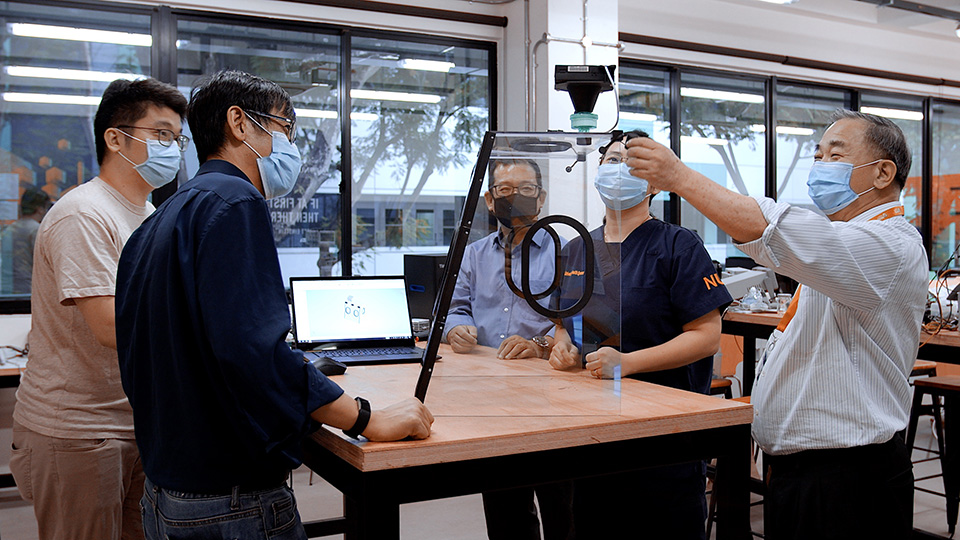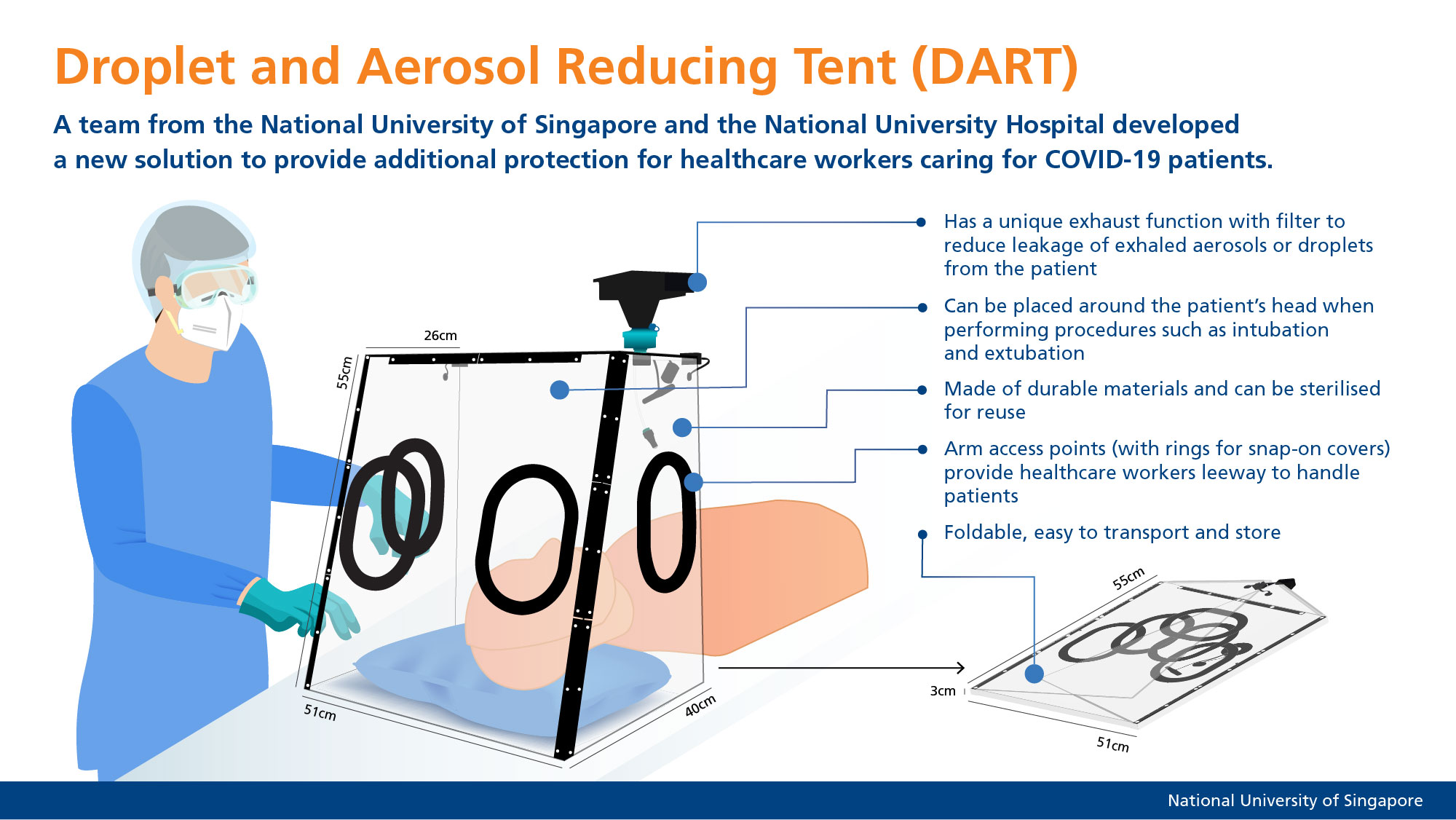
In the continued fight against the COVID-19 pandemic, a team of NUS researchers has invented a device that serves as a physical shield to reduce healthcare workers' exposure to SARS‑CoV‑2 pathogens.
Known as the Droplet and Aerosol Reducing Tent (DART), it is a portable, tent-like structure that can be placed around the patient's head when healthcare workers perform procedures like intubation or extubation. It can lessen the infection risk of such droplet and aerosol generating procedures by providing an extra layer of protection between the healthcare workers and the patient. It also helps to limit contamination to the surrounding environment, which could be a source of disease transmission.
The DART was designed in collaboration with doctors from the National University Hospital (NUH). It is lightweight and foldable, making it easy to transport, store and sterilise. It is also simple and fast to set up and connect to a vacuum pump, with an inbuilt High Efficiency Particulate Air filter that can reduce leakage of exhaled aerosols or droplets from the patient out of the confines of the DART.
The NUS team was led by Professor Freddy Boey, NUS Deputy President (Innovation & Enterprise), and Associate Professor Yen Ching-Chiuan, Co-Director of the Keio-NUS CUTE Center. The team comprises Dr Alfred Chia from NUS Biomedical Engineering, Mr Eason Chow from Keio-NUS CUTE Center, doctoral student Mr Raymond Hon from the NUS Division of Industrial Design, as well as researchers from NUS Engineering. The NUS team worked with Dr Deborah Khoo, Dr Wong Weng Hoa, Associate Professor Ti Lian Kah and Associate Professor Sophia Ang from the NUH Department of Anaesthesia.
"This collaborative effort demonstrates NUS' commitment to innovative and impactful research that benefits our community. Since the beginning of the COVID-19 outbreak, the University has been combatting the crisis on multiple fronts, from vaccine development to preventing false rumours online. With the DART, the NUS-NUH team has the potential to make a dramatic difference by improving the safety of frontline healthcare workers," said NUS President Professor Tan Eng Chye.
The multi-disciplinary team took less than two months to develop DART and validate its performance. "The quick invention and deployment of DART was made possible through a close collaboration between the NUS and NUH teams, which allowed multiple refinements to be made to the prototypes within a very short time," shared Prof Boey.
The need for increased infection control
The COVID-19 pandemic dramatically increased the need for infection control when intubating patients. Intubation is the placement of a flexible plastic tube into the windpipe to maintain an open airway or to serve as a conduit through which to administer certain drugs. The removal of this plastic tube is known as extubation.
These are risky procedures that may put clinicians in danger of becoming infected because of droplets or aerosols from the patient.
Evidence from the Severe Acute Respiratory Syndrome (SARS) outbreak in 2003 showed that healthcare workers involved in intubation were more likely to contract the disease compared with those who did not. This risk has similar implications for the current coronavirus outbreak, affecting anaesthesiologists, operating theatre staff, intensive care unit staff, and even first responders who are required to intubate collapsed patients in the COVID-19 general ward.
"Healthcare workers caring for patients run the risk of being exposed to known, suspected, or even asymptomatic COVID-19 patients. The DART serves as an additional physical barrier to infection and provides enhanced protection for healthcare staff at a time when they need it the most, giving us greater peace of mind and enabling care to continue safely for both patients and healthcare workers in the hospitals." said Dr Khoo.
Next steps
The research team has produced 25 prototypes which are being tested in different departments and hospitals of the National University Health System (namely NUH, Ng Teng Fong General Hospital and Alexandra Hospital), Tan Tock Seng Hospital, Changi General Hospital, Thomson Medical Centre, and several private hospitals operated by Parkway Hospitals Singapore.
Describing the impact of the DART, Dr Justinian Zai, a Senior Resident Medical Officer from Mount Elizabeth Novena Hospital, said, "The DART offers well thought out portable protection against infective aerosols during endotracheal intubation, and would be an invaluable asset in any operating theatre or ICU."
The team is looking to swiftly refine the DART based on the feedback provided by different medical departments, and hopes to provide the device as a form of medical aid to Singapore hospitals as well as hospitals in the region. The team will also be partnering Temasek Foundation to distribute the DART, complementing its donation of ventilators to the region.
The researchers are also working with NUS Dentistry to develop a similar protective device, which will shield dentists in the same way, and could be available within the next few months.
The DART is one of the innovations developed by NUS to tackle the current global pandemic. Since the start of the crisis, the University has been proactively participating in the fight against COVID-19 on different fronts. Read more about the research ranging from diagnostic tests to vaccine development here, as well as the use of information and technology solutions here.

This article was first published on 25 June 2020 in NUS News.





